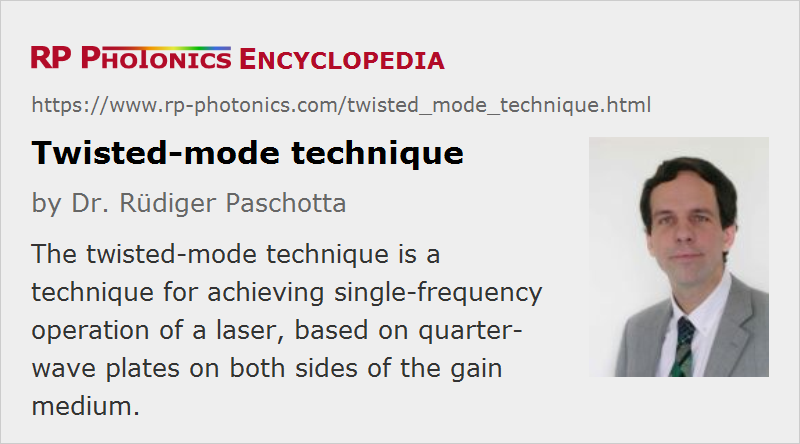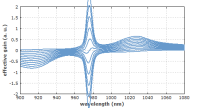Twisted-mode Technique
Definition: a technique for achieving single-frequency operation of a laser, based on quarter-wave plates on both sides of the gain medium
How to cite the article; suggest additional literature
Author: Dr. Rüdiger Paschotta
For a continuous-wave laser with a linear resonator, there is a standing-wave interference pattern in the gain medium. This gives rise to the effect of spatial hole burning, which leads to stronger gain saturation for the lasing resonator mode than for other modes. As a consequence of this, single-frequency operation is usually not achieved, unless the gain bandwidth is smaller than the bandwidth of the optical elements of the resonator.
The twisted-mode technique [1] allows for single-frequency operation even for a large gain bandwidth. It involves the use of quarter-wave plates at both ends of the gain medium. Linearly polarized light coming from one end of the laser resonator becomes circularly polarized when going through a quarter-wave plate, the axis of which is oriented at 45° to the linear polarization axis. After going through the gain medium, is transformed to a linear state again. On the way back, the light becomes circularly polarized once again in the gain medium. The rotation directions are such that an interference pattern does not occur, and the optical intensity is not spatially modulated. There is actually an interference pattern for each linear polarization component, but both patterns are out of phase, so that the total optical intensity is constant along the propagation direction. In effect, spatial hole burning is suppressed, and single-frequency operation can be achieved much more easily.
The twisted-mode technique has originally been applied to solid-state bulk lasers, but it also works in fiber lasers [3, 4]. It can not be applied with anisotropic laser crystals, having a polarization-dependent gain.
Questions and Comments from Users
Here you can submit questions and comments. As far as they get accepted by the author, they will appear above this paragraph together with the author’s answer. The author will decide on acceptance based on certain criteria. Essentially, the issue must be of sufficiently broad interest.
Please do not enter personal data here; we would otherwise delete it soon. (See also our privacy declaration.) If you wish to receive personal feedback or consultancy from the author, please contact him e.g. via e-mail.
By submitting the information, you give your consent to the potential publication of your inputs on our website according to our rules. (If you later retract your consent, we will delete those inputs.) As your inputs are first reviewed by the author, they may be published with some delay.
Bibliography
| [1] | V. Evtuhov and A. Siegman, “A 'twisted-mode' technique for obtaining axially uniform energy density in a laser cavity”, Appl. Opt. 4 (1), 142 (1965), doi:10.1364/AO.4.000142 |
| [2] | C. S. Adams et al., “Single-frequency operation of a diode-pumped lanthanum-neodymiumhexaaluminate laser by using a twisted-mode cavity”, Opt. Lett. 18 (6), 420 (1993), doi:10.1364/OL.18.000420 (example of a typical twisted-mode bulk laser) |
| [3] | D. I. Chang et al., “Single-frequency erbium fibre laser using the twisted-mode technique”, Electron. Lett. 32 (19), 1786 (1996) (first application of twisted-mode technique to a fiber laser), doi:10.1049/el:19961194 |
| [4] | P. Polynkin et al., “Single-frequency laser oscillator with watts-level output power at 1.5 μm by use of a twisted-mode technique”, Opt. Lett. 30 (20), 2745 (2005), doi:10.1364/OL.30.002745 |
| [5] | Y. Kaneda et al., “Narrow-linewidth operation of folded 1178 nm VECSEL with twisted-mode cavity”, Opt. Express 27 (19), 27267 (2019), doi:10.1364/OE.27.027267 |
See also: single-frequency lasers, single-frequency operation, spatial hole burning, polarization of light
and other articles in the categories lasers, methods
 |







If you like this page, please share the link with your friends and colleagues, e.g. via social media:
These sharing buttons are implemented in a privacy-friendly way!